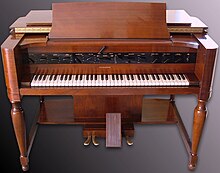
Back نوفاكورد Arabic Novachord German Novachord Esperanto Novachord Finnish Novachord French Novachord Italian ノバコード Japanese Novachord Polish Novachord SIMPLE
This article includes a list of general references, but it lacks sufficient corresponding inline citations. (February 2011) |
| Novachord | |
|---|---|
 Hammond Novachord | |
| Manufacturer | Hammond |
| Dates | 1939–1942 |
| Technical specifications | |
| Polyphony | 72 voices |
| Oscillator | 12-semitone oscillators + 5-octave dividers |
| LFO | 6-channel electromechanical vibrato |
| Synthesis type | Subtractive analogue |
| Filter | Three bandpass filters, one lowpass filter, one highpass filter (in parallel with fixed frequency) |
| Attenuator | Envelope with seven preset shapes |
| Hardware | Vacuum tubes |
| Input/output | |
| Keyboard | 72 notes |
The Novachord is an electronic musical instrument often considered the world's first commercial polyphonic synthesizer.[1][2][3] Incorporating many circuit and control elements found in modern synthesizers, and using subtractive synthesis to generate tones, it was designed by John M. Hanert, Laurens Hammond and C. N. Williams, and was manufactured by the Hammond company.[4] Only 1,069 Novachords were built over a period from 1939 to 1942. It was one of very few electronic products released by Hammond that was not intended to emulate the sound of an organ.
- ^ Cirocco, Phil (2006). "The Novachord Restoration Project". CIROCCO MODULAR SYNTHESIZERS. Retrieved 26 April 2011.
- ^ Morris, Jan (1998). Manhattan '45. JHU Press. p. 47.
- ^ Davison, Annette (2009). Alex North's A streetcar named Desire: a film score guide. Scarecrow Press. p. 82.
- ^ Steve Howell; Dan Wilson. "Novachord". Hollow Sun. Retrieved 26 April 2011. See also site's 'History' page